


Introduction:
Dog[LAB]02 is a multi-robot installation (including 14 dogs at the moment) presented as a 15mn performance. It is a follow-up to a first installation named Dog[LAB01
Dog[LAB]01:
Dog[Lab]01 which is the beginning of this work, started in 2003 with 5 different robotic dogs, and then two new dogs joined the group in 2004. This installation has been awarded two first prizes: VIDA 6 (Spain) and Digita Awards NHK (Tokyo) and has many times been exhibited and published in several countries: Japan (Media Art Festival, Digital Stadium), South korea (Sciart V 3), Austria (Ars Electronica), Spain (International Art Fair ARCO 04), England (Machinista) and in France (International Festival EXIT, VIA, Lille 2004, Arborescence...).
For further information on Dog[LAB]01 click here
Description:
Dog[LAB]02 is the second step of the Dog[Lab]01 project, which was gathering seven hybrid and transgenic different robotic dogs, the next phase in the elaboration of these new hybrid animal species.
After the experimental study and the laboratory
analysis of several individual animals, the creation of a whole pack of clones
can be done. Once created in laboratory, these new species can be (re)produced.
We go from an individual prototype to a pack of clones… an undissociable
idea from the idea of a reproductive cloning.




It is a question of taking the model "Dolly" and creating a whole identical herd of it.
Everybody seems to be against human cloning, whereas animal cloning doesn’t seem to pose any problems. It is largely used in the breeding industry bringing greater profits and yet it is not employed for therapeutic purposes. Both sheep and bovine have already attracted large interest from scientists and industrialists and have been transformed (improved) by genetic selection and successive crossings. Hopefully the real genetic manipulations they have gone through have often been less successful than expected. With the creation of this new specie "Dolly" a reproduction can be envisaged.
Thus the pack of Dolly is a
group of 14 animals with the specific characteristics of this specie that is:
Dog: 50%, Ewe: 30%, Cow: 15%, Sheep: 5%. They are morphologically identical,
have the same size, weight and coat so that people might think they are clones.
This is of course caricatural because it is well known today that clones share
the same genetic inheritance but not a perfectly identical morphology and in
any case a similar character. Copycat, the first cloned kitten which was not
the exact copy of the ordinal, fortunately came to underline in 2001 this non-commercial
aspect of the reproductive cloning.
Synopsis:
 |
Here we are now with a pack of cloned "Dolly" where each robot evolves autonomously in this big artificial limited space, a big common meadow now. The clones have left the laboratory and seem from now on able to evolve in community. They move slowly, bleat, graze… Everything seems normal excepted the strange morphological similarity of the animals of this herd. Each clone will move autonomously. Although their behaviour will be roughly similar, it will not be identical. However both sheep and bovines specimens have encountered difficulties for their cloning (BSE: Mad Cow Disease, Progeria, premature ageing, abnormal size and various pathologies). Thus this new specie is suffering of these different problems. |
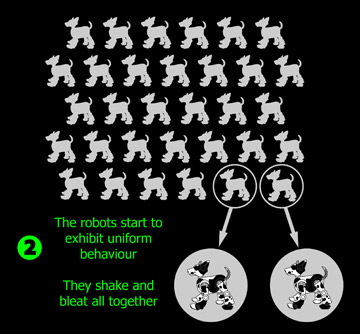 |
Suddenly these pathological symptoms start to appear and invade the whole pack. One animal, then two, then three… the whole pack seems touched by this epidemic. The animal shake, stumble, fall down, get up painfully. Then the pack of clones starts to exhibit an uniform and synchronous behaviour: all the robots start to shake and bleat all together at the same time. They can't stand up any more on their feverish paws. The mad cow disease seems to be here! |
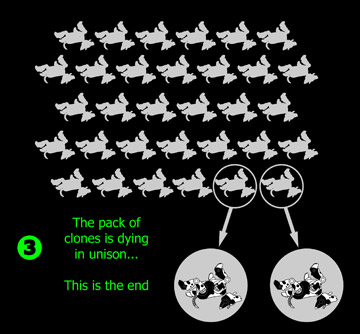 |
The tremors become more and more intense, then suddenly, they all fall down at the same time. Once lying on the floor, they groan with quavering bleats which seem to be insignificant when they are alone, but when we hear the 30 cries of the dying clones, they become frightening. This is the end… The clones become clones again. The pack is dying in unison. |
Some precisions:
By using a whole pack of robotic dogs, the aim is to create a much more frightening impression than was possible with the single dog of Dog[LAB]01, which often inspired amusement – something the artist did not intend. The use of multiple robots also evokes contemporary anxieties about cloning, the spread of new diseases, and genocide. The dramatic death of the robots challenges the utopian dreams of transhumanists in which robotic technology is seen as a means of overcoming our mortality.
As Luciana Parisi emphasizes, the novelty of Dolly, the cloned sheep, was not that you could clone an adult mammal, but that our genes and organs can be designed and shaped. The point is not solely that it is now possible to reproduce artificially, but that human beings can be reproduced from scratch. Artificial sex and reproduction marks the apex of the Brave New World where humans overcome death through the proliferation of identical copies.
Technical Functioning:
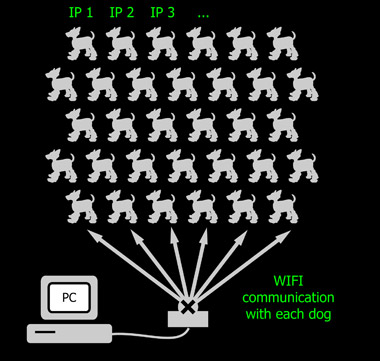 |
To coordinate and synchronize the movements of the different robots it is necessary to be able to communicate with them in real time, and this in a reliable and fast way. Thus a smd wifi device has been developed and integrated to the robots. Each robot have now its own IP address and a central PC can communicate with each of them. The data are managed by the PC in a
Delphi application and are sent back to the robots through a wifi access
point directly connected to the computer. The device works in a local
network mode and doesn’t go trough Internet. |
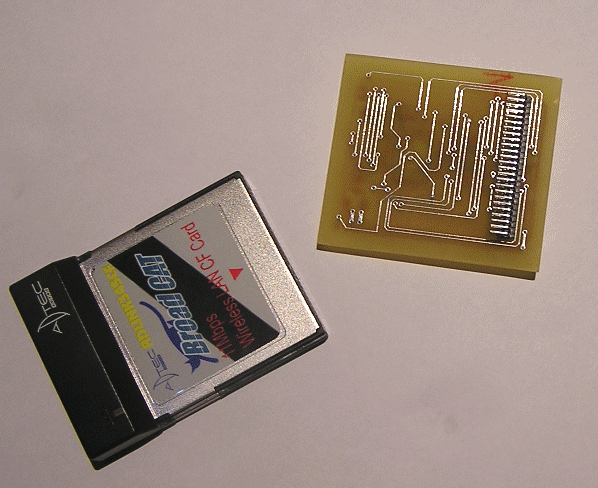 |
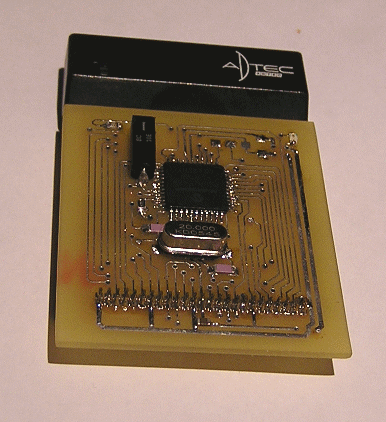 |
The device which
has been used is a smd wifi
PicoIP card especially created by Jean-Pierre Mandon. This device
is a monocard using a PIC 18LF458 microcontroller and a Wifi compact flash
card. The processor assures the management of the compact flash card and
allow to exchange data via a wifi network. It is a Wifi/serial converter
which enables to control remote devices over the network. |
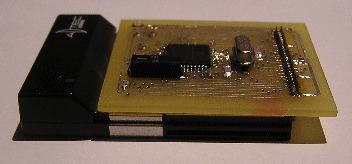 |
 |
Dog fitted with a RADIO module |
 |
Dog fitted with a WIFI module #1 |
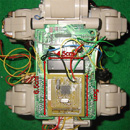 |
Dog fitted with a WIFI module #2 (final version) |
Partnerships:
Technical assistance: Jean-Pierre
Mandon
Partially finaced by the Leverhulme
Trust Grant after a residence at the BRL:
Bristol Robotics Laboratory on an invitation of Dylan
Evans.
Links:
Diary
of the residence on Watershed website
BRL: Bristol Robotics laboratory
(New site)
IAS LAB: Intelligent
Autonomous Systems Laboratory (Old site)
Dr Dylan Evans
Jean-Pierre Mandon
Western Daily Press:
Framers anger!
BBC
NEWS